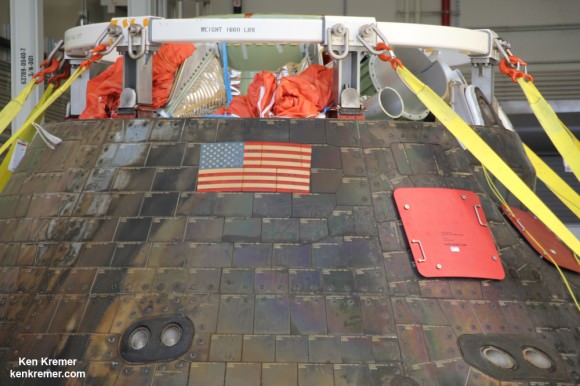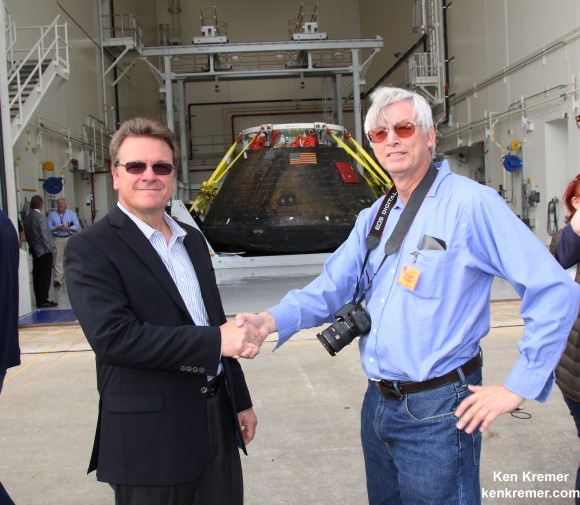KENNEDY SPACE CENTER, FL – After a history making journey of more than 66,000 miles through space, ocean splash down and over 2700 mile cross country journey through the back woods of America, NASA’s pathfinding Orion crew capsule has returned to its home base at the Kennedy Space Center in Florida.
“The Orion mission was a spectacular success,” said Jules Schneider, Lockheed Martin Program manager for Orion at KSC, during a homecoming event attended by space journalists including Universe Today on Friday, Dec. 19, 2014.
“We achieved 85 of 87 test objectives,” noted Schneider. “Only an up righting air bag did not deploy fully after splashdown. And we are looking into that. Otherwise the mission went extremely well.”
Orion’s early homecoming was unexpected and a pleasant surprise since it hadn’t been expected until next week just prior to Christmas.
Orion flew on its two orbit, 4.5 hour flight maiden test flight on the Exploration Flight Test-1 (EFT-1) mission that started NASA’s long road to send astronauts beyond Earth and eventually to Mars in the 2030s.
The media were able to see the entire Orion capsule from top to bottom, including the exposed, blackened and heat scorched heat shield which had to protect the vehicle from fiery reentry temperatures exceeding 4000 F (2200 C).

Top view of NASA’s maiden Orion spacecraft after returning to NASA’s Kennedy Space Center in Florida on Dec. 19, 2014. Credit: Ken Kremer – kenkremer.com
Orion is being stored for now inside the Launch Abort System Facility (LASF)
“The heat shield worked extremely well and did its job,” Schneider told Universe Today.
Engineers took three samples from the 16.5 foot diameter heat shield and they are in for analysis.
“I don’t know if you can tell, we’ve actually taken a few core samples off the heat shield already and we’re looking at those,” said Schneider. “We will be removing the heat shield from this vehicle later in February so we will get an ever better look at it.”
One of the main objectives was to test the heat shield during the high speed atmospheric plummet of about 20000 mph (32000 kph) that reached approximately 85% of what astronauts will experience during a return from future voyages to Mars and Asteroids in the next decade and beyond.
“All of Orion’s system performed very well,” Schneider told me in an interview beside Orion.
“And the capsule used only about 90 pounds of its about 300 pounds of hydrazine propellant stored on board.”
“All of the separation events went beautifully and basically required virtually no maneuvering fuel to control the attitude of the capsule. The expected usage was perhaps about 150 pounds.”
“Therefore there is a lot more hydrazine fuel on board than we expected. And we had to be cautious in transporting Orion across the country.”

Lockheed Martin is the Orion prime contractor.
The Orion arrived module arrived back at KSC, Thursday afternoon after being hauled across our country mostly on back country roads, and with no publicity or fanfare, on an unmarked flat bed truck to minimize interaction with the public.
“It was like a black ops operation,” said one of the team members responsible to safely transporting Orion from Naval Base San Diego to KSC.
NASA obtained special permits to move Orion from all the states travelled between California and Florida.
“We didn’t want any publicity because the capsule was still loaded with residual toxic chemicals like ammonia and hydrazine.” These were used to power and fuel the capsule.”
Orion’s test flight began with a flawless launch on Dec. 5 as it roared to orbit atop the fiery fury of a 242 foot tall United Launch Alliance Delta IV Heavy rocket – the world’s most powerful booster – at 7:05 a.m. EST from Space Launch Complex 37 (SLC-37) at Cape Canaveral Air Force Station in Florida.
The unpiloted test flight of Orion on the EFT-1 mission ignited NASA’s roadmap to send Humans to Mars by the 2030s by carrying the capsule farther away from Earth than any spacecraft designed for astronauts has traveled in more than four decades.
Humans have not ventured beyond low Earth orbit since the launch of Apollo 17 on NASA’s final moon landing mission on Dec. 7, 1972.
Watch for more details and photos later.

Watch for Ken’s ongoing Orion coverage from onsite at the Kennedy Space Center about the historic launch on Dec. 5.
Stay tuned here for Ken’s continuing Earth and planetary science and human spaceflight news.



Am glad NASA is getting a LOT of positive feedback lately.. especially the $$$ from congress! GO Orion!
Lets just say on the off chance, there is a problem with the SLS development program… something major. Could two or more boosters be added to the Delta IV config./stack and be used as a substitute? Rather a Delta ‘Super Duper Heavy’ config.?
No plans for that AFAIK
Quick question: Why does the American flag on the Orion capsule show no discoloration or damage from re-entry like the rest of the heat shield does?
The pictures clearly show plenty of discoloration and damage to the American Flag similar to the rest of the capsule
Ken, I’m not trying to insult your photographs or anything. The flag and hatch door just seemed relatively unaffected by the heat of re-entry, while the heat shield is clearly discolored all over.
“NASA is getting a LOT of positive feedback lately.. ” so here is a negative one:
Who came up with the idea to haul the capsule cross country with hazardous material on board?
“We didn’t want any publicity because the capsule was still loaded with residual toxic chemicals like ammonia and hydrazine.”
Would it be that difficult to unload these two liquids once the capsule was secure on land? In that case the capsule could have made a glorious “homecoming trip” on major highways instead such a “night & fog action” (as we Germans say).